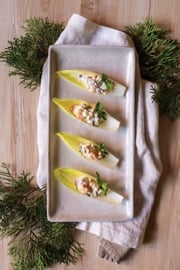
Spring is the season for asparagus. The tender green shoots popping out of the soil in early spring are especially prized for their fleeting seasonal appearance. Asparagus is extremely versatile, offering flavour to every recipe. For this recipe, you can make an authentic pizza dough or use a ready-made dough; you can also substitute with a gluten-free alternative base.
Asparagus Smoked Salmon Flatbread with Spring Greens
Ingredients
Pizza dough
2 cups (500 mL) all-purpose, whole wheat, or spelt flour, plus extra
1 pkg (2 1/4 tsp/11 mL) active dry yeast
1 tsp (5 mL) raw cane sugar
1/2 tsp (2 mL) kosher salt
1 Tbsp (15 mL) extra-virgin olive oil, plus extra for coating bowl
2/3 cup (160 mL) warm water, 105 to 115 F (40 to 46 C)
Cornmeal, for dusting
Asparagus smoked salmon flatbread
2 Tbsp (30 mL) extra-virgin olive oil, divided, plus extra
1/3 cup (80 mL) grated mozzarella, or dairy-free substitute
1 small sweet onion, peeled and thinly sliced into rounds
3 tsp (15 mL) chopped fresh dill, divided, plus extra
1/4 tsp (1 mL) sea salt, plus extra
1/8 tsp (0.5 mL) freshly ground black pepper, plus extra
1 cup (250 mL) fresh arugula or 1 small bunch fresh watercress
1/3 cup (80 mL) full-fat plain Greek yogurt, about 10% fat, or plain soy yogurt
1 tsp (5 mL) Dijon mustard
1/2 lb (225 g) thick stemmed asparagus
3 oz (85 g) thinly sliced cold-smoked salmon, cut into strips
Fresh lemon juice (optional)
Nutrition
Per serving:
- calories314
- protein21g
- fat16g
- saturated fat7g
- trans fat0g
- carbohydrates23g
- sugars6g
- fibre3g
- sodium <612mg
Directions
01
Coat medium-sized bowl with olive oil.
In food processor, combine flour, yeast, sugar, and salt. Pulse a few times to blend. With motor running, add 1 Tbsp (15 mL) olive oil and warm water. Continue processing until dough forms a ball and pulls away from the sides of the bowl. If too sticky, whirl in a couple more tablespoons of flour. Process for 1 more minute. Transfer to prepared bowl, turning dough in bowl to evenly coat. Cover with clean towel and set aside in warm place to rise for about 45 minutes to 1 hour.
Preheat oven to 475 F (240 C). Lightly oil baking sheet and set aside.
On lightly floured surface, roll dough into a rectangle about 15 x 6 in (38 x 15 cm). Lift onto prepared baking sheet. Brush with 1 Tbsp (15 mL) oil and scatter with mozzarella. Set aside.
In large frying pan, heat 1 Tbsp (15 mL) oil over medium-high heat. Add onion slices and sauté until soft, about 5 to 7 minutes. Reduce heat and add a splash of water if they begin to stick and darken too quickly. Transfer to medium bowl and fold in 2 tsp (10 mL) chopped fresh dill, salt, and pepper. Set aside to cool.
Pick through arugula or watercress leaves, trimming away stalks. Wash and spin dry. Set leaves aside. In small bowl, combine yogurt, Dijon, and remaining 1 tsp (5 mL) chopped fresh dill. Whisk to blend. Set aside.
Shave asparagus spears lengthwise into long thin strips, discarding tough ends. Place in bowl and drizzle with a splash of oil.
Scatter sautéed onions overtop mozzarella on pizza dough, leaving 1/2 in (1.25 cm) border. Pile asparagus strips evenly overtop. Bake pizza in preheated oven for 10 to 15 minutes, or until crust edges are deep golden and asparagus is lightly charred.
Remove and transfer pizza to wooden serving board. Arrange smoked salmon strips in twists on top and scatter with watercress. Dollop with yogurt and lightly season with additional black pepper, if you wish. Cut into wedges and splash with a little olive oil and lemon juice, if desired. Cut into wedges and serve garnished with additional sprigs of fresh dill.
Tip: Make your own pizza dough in a flash, or purchase gluten-free flatbread and bake with toppings in oven only until piping hot. Substitute watercress with microgreens or pea shoots.
Vegan option: Use dairy-free cheese ingredients and make shaved carrot lox to replace the smoked salmon.





